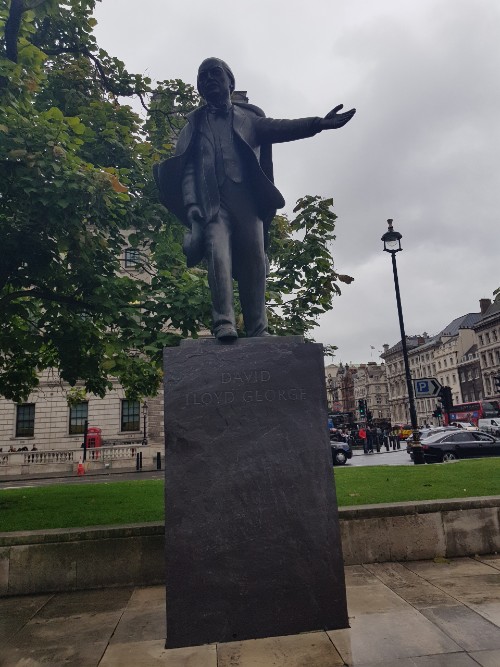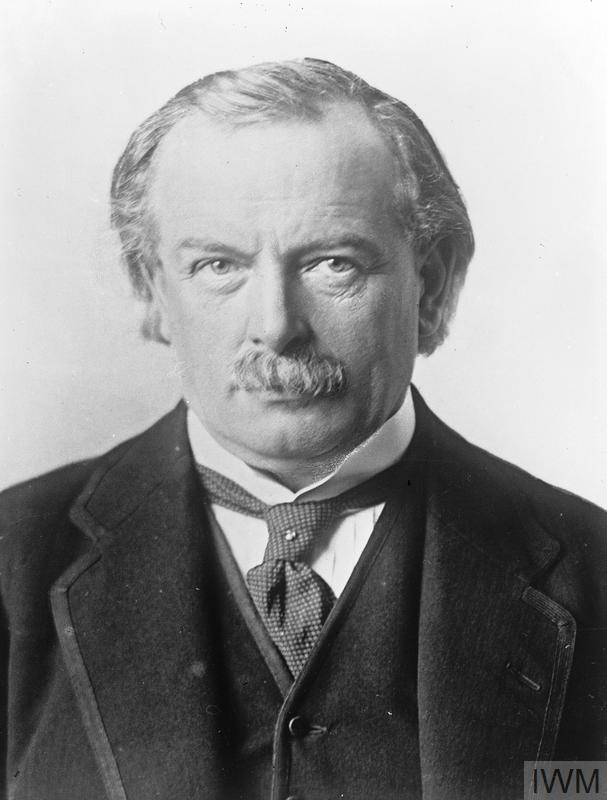Statue David Lloyd George
David Lloyd George (17 Jan 1863- 26 Mar 1945) was a Liberal Party Member of Parliament who was appointed as President of the Board of trade in 1905 before becoming the Chancellor of the Exchequer on 12 April 1908 under Prime Minister H.H. Asquith. On 25 May 1915, following the 'Shell Crisis'. Lloyd George was appointed to the newly created Minister of Munitions positions. He managed to deal with labour problems and workers welfare to greatly improve Britain's munitions output. On 5 July 1916, Lord Kitchener was killed when HMS Hampshire struck a mine and Lloyd George succeeded him in the position of Secretary of State for War the following day. With Asquith proving ineffective as Prime Minister, Lloyd George succeeded him on 6 December 1916 and served in the role until 19 October 1922. During the war years he implemented the convoy system, introduced rationing and increased home farming output. After the war he was a major player in the Paris Peace Conference leading to the Treaty of Versailles.
Lloyd George was also instrumental in getting Crown and Government approval to repatriate an 'Unknown Warrior' from the Western Front to be buried in Westminster Abbey.
After WW1 and the Treaty of Versailles, Lloyd George began to become 'pro-German' in the belief that they had been mistreated in the Treaty. When Hitler came to power he was praised him and Germany and after a meeting with Hitler in 1936 he called him 'the greatest living German'
Lloyd George requested that the temporary Cenotaph designed by Edwin Lutyens be erected for the Peace Day celebrations in July 1919 and following its acceptance by the British public that it should become a permanent structure in Portland stone to be unveiled on 11 December 1920.
Lloyd George was also instrumental in getting Crown and Government approval to repatriate an Unknown Warrior from the Western Front to be buried in Westminster Abbey.
Lloyd George had a dislike of the then British Prime Minster, Neville Chamberlain, and following Chamberlains handing of the Norway Campaign in May 1940 he made one of his last speeches in Parliament that totally undermined Chamberlain and opened the door for Winston Churchill.
Do you have more information about this location? Inform us!
Source
- Text: Sharky Ward
- Photos: Anthony (Sharky) Ward (1), IWM Non Commercial Licence (2)
Nearby
Museum
- Churchill Museum and Cabinet War Rooms - London
- Household Cavalry Museum - London
- London Scottish Regiment Museum - London
Point of interest
- Supreme Court of the United Kingdom - London
- Palace of Westminster - London
- 10 Downing Street - London
Monument
- Monument Winston Churchill - London
- Statue of Jan Smuts - Westminster
- War Memorial Middlesex and the Middlesex Regiment - London
Cemetery
- Graves Westminster Abbey - London
- Tomb of the Unknown Warrior in Westminster Abbey - London
- Commonwealth War Grave Savoy Chapel - Westminster (London)
Remembrance Stone
Fortification
- Pillbox Clapham Junction - Battersea
- Pillbox Clapham Junction - Battersea
- Pillbox Clapham Junction - Battersea







